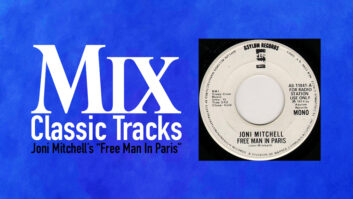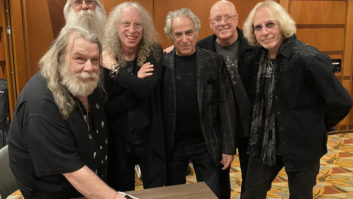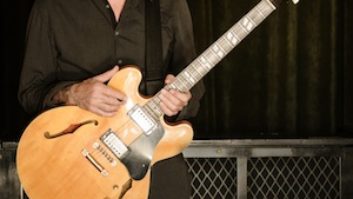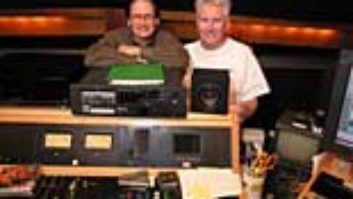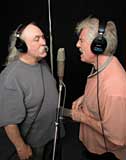

Left: Crosby and Nash harmonize into a Neumann U67. Right: Producer/engineer Nathaniel Kunkel takes a quick break from his Pro Tools rig.
Photo: Mr. Bonzai
Passing outside Center Staging in Los Angeles, it would be difficult to imagine what was taking place within the large rehearsal complex. Inside, David Crosby and Graham Nash were collaborating on their first duo album in 26 years, in an unconventional, open recording environment pioneered by producer/engineer Nathaniel Kunkel. Kunkel — whose recent credits include working with Sting, James Taylor, Crystal Method, Deep and Bites, and Lyle Lovett — built a portable recording package he calls Studio Without Walls. With this high-end, high-resolution collection of gear, Kunkel can work almost anywhere — from Sting’s home in Los Angeles, to live concerts, to Center Staging, where they are tracking Crosby Nash, due out this month on Sanctuary Records. Rounding out the talent roster are Lee Sklar on bass, Dean Parks and Jeff Pevar on guitars, Crosby’s son James Raymond on piano and Kunkel’s father, co-producer Russ Kunkel, on drums.
A well-stocked studio on wheels: Nathaniel Kunkel’s mobile gear racks feature three Genex 8-channel A/D converters, an Alan Smart C1 limiter/compressor, two Empirical Labs Distressors, a host of GML and TC Electronic gear (including 12 channels of GML mic pre’s and four TC Finalizers), a Z-Sys 8×8-channel router, an Otari UFC-24 multitrack digital-format converter, a DTS professional encoder and decoder, a Tascam DA-78 HR digital recorder with AES interface and a Brainstorm Electronics Distripalyzer. The mic assortment, however, was kept to a minimum: “Just about every microphone was from Audio-Technica, except for my Neumann U67 on vocals, B&K 4011s on acoustic guitars and drum overheads, Shure SM57s in front of the guitar amps and a Sennheiser MD-431 on snare,” says Kunkel.
David Crosby perfects a guitar track. “We gave everyone good headphone mixes,” says Nathaniel Kunkel. “You have a head unit that you plug 16 channels into and a Cat-5 Ethernet cable that goes to a router with power. Everyone had their own headphone mixers. We put 50-foot cables on all of them so people could take their headphone box wherever they wanted.”
David Crosby’s son James Raymond, carrying on the musical tradition: “When David was in danger of dying with his liver transplant, he was on the cover of People magazine,” says Graham Nash. “James’ adopted parents, who are wonderfully warm people and brought him up magnificently, knew who his father was. Because he was in danger of dying, they felt they owed it to James to tell him. And when they told him, he wanted to meet David. Now he is in David’s band, CPR.” Raymond’s piano was miked with Audio-Technica 4050s.
“What Nathaniel does that is most valuable, apart from his technical expertise and his sense as a musician, is that he shortens the distance between my idea for the music and the recorded music,” says Graham Nash. “Instead of an idea taking 10 minutes to do, it takes 20 seconds and then I am on to the next thing. That is unbelievably important to us as musicians.” “He really gets what the content of a song is and understands what you are trying to do,” adds David Crosby.
Guitarist Jeff Pevar works out a riff while Graham Nash looks on. “It’s always live when you are working with this caliber of artists and musicians, so ultimately, getting comfortable is the most important thing,” says Nathaniel Kunkel. As for isolation issues, Kunkel explains that a logical approach is the key to success. “If you want bashing drums and really loud guitar and piano, you can’t cut them all at the same time. You have to use your head because you are not in a traditional recording studio, but you can work anywhere you want and capture any moment that is being created.”
Drummer Russ Kunkel, between takes. “I’ve known Russell since he was 19 years old,” says Graham Nash. “He was on every Crosby/Nash record that we made and he was the drummer in the 1974 stadium tour that CSNY did, so we go back a long way.” Son Nathaniel miked the set with Audio-Technica ATM 25s and 35s, along with B&K 4011s on overheads, a Sennheiser MD 431 on the snare drum, and a Shure Beta 52 and Yamaha SubKick on the kick drum.

Producer/engineer Nathaniel Kunkel
Photo: Mr. Bonzai
Nathaniel Kunkel’s Studio Without Walls is based around a Sony DMX-R100 console, a Pro Tools|HD2 rig and JBL LSR 5.1 monitoring system, all in a large, open space. “It’s a great way to work because I don’t have to press a talkback button and walk through three doors,” says Kunkel. “There is no more compromise about this setup than if I were to do it at a big traditional recording studio.” “I couldn’t imagine doing it any other way now that I’ve done it this way,” adds David Crosby. “The communication is so much faster and clearer. The proof is in the pudding.”

• Check out more In-Studio photos here.
• Click
here to read in-depth interviews with David Crosby, Graham Nash and Nathaniel
Kunkel.
